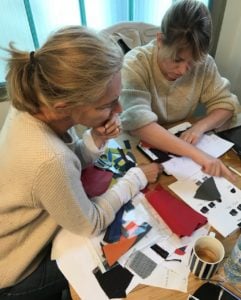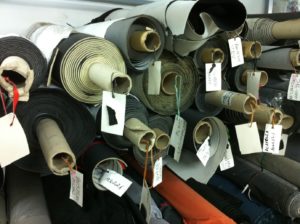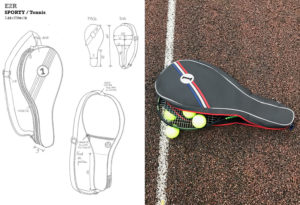Behind the scenes of creation
As you have seen in our previous articles, this period of confinement is conducive to writing and creation. Everything is stopped and this gives us time to share with you our ideas, desires; everyone takes the time to do what they never have time to do.
We share on our Instagram account (@entre2retros) some pictures of the workshop or our creation sessions. Finally, here are some more details on « how we create our beautiful bags ».
Starting point: our creative process is completely reversed from the classic process.
What does this mean?
When a brand launches a collection, it is going to be inspired by the trend and define the universe from which it is going to draw its inspiration. From this trend book, it will choose the materials that will compose its collection, design it, buy the materials and have it produced. Here is a shortened version of how a collection is created.
Why do we proceed differently?
We recover scraps of automobile fabric, i.e. we buy a stock of fabric that is destined to be thrown away or destroyed. This stock is therefore in defined quantities, and the quantities per colour and type of fabric are random.
We will therefore have to imagine which fabric could correspond to which model: each fabric having different characteristics in terms of resistance, rendering…
On the other hand, we also have to think upstream about the quantity we will want to produce: if we make a travel bag, we will have to use a larger quantity of fabric than for a toilet bag. The same applies if we want to make an entire collection in the same fabric, we have to anticipate the quantity.
When a fabric is out of stock, we have to rethink the product. In a classic process, if a product sells well, it is possible to buy back material to produce restocking.
This may not seem difficult, but in reality it’s a puzzle, because how can you anticipate which model will sell the most? How can you know what a fabric will look like before assembling the prototype?
It’s difficult. Sometimes we draw a product and when the prototype arrives, we find the product horrible and are super disappointed.
Now that you know the context, how do we proceed?
The style team is made up of Virginie, the brand’s creator, and Julie, the stylist.
Their roles are different and complementary.

Virginie and Julie in creation session
Virginie analyzes last season’s sales, sees the models that work and that she wants to reissue, the new models she wants to create… She defines a collection plan that she shares with Julie. Julie also has a say in the plan and challenges Virginie’s ideas.
Once this plan is established, all that’s left to do is create the designs.
Julie and Virginie determine together which fabric matches which design. Then they decide together which patterns they want to apply, choose the colours for all the details.
Julie’s eye is fundamental on the colour part, the role of the stylist is to bring the little touch that makes the product both trendy and different, that it will have that little extra that sells.
The number of details to choose from in a bag is enormous: from the colour of the sewing thread, to the choice of the zip, the piping (the little sausage on the edge of the bag), the length of the handles…
Girls can sometimes spend hours determining the height of the handle, the width between the handles, the colour of the thread… Details make the difference and 1cm more or less can change the look of your bag considerably.
Crazy isn’t it?

Once everything is chosen, Julie goes home and produces a technical sheet that summarizes all the elements of the bag.
This sheet will be sent to the workshop.
Based on the sheet, a model maker will create all the patterns for the bag, that is to say all the parts that make up the bag. A prototype will be assembled.
This prototype is then checked, measured, inspected and if necessary modifications are made.
We might as well tell you that the number of hours spent per product is enormous, and that nothing is left to chance.
This is only a part of the work, as you can imagine, we will tell you in another article how it goes in the workshop.
Feel free to share this article with your friends or on social networks!


